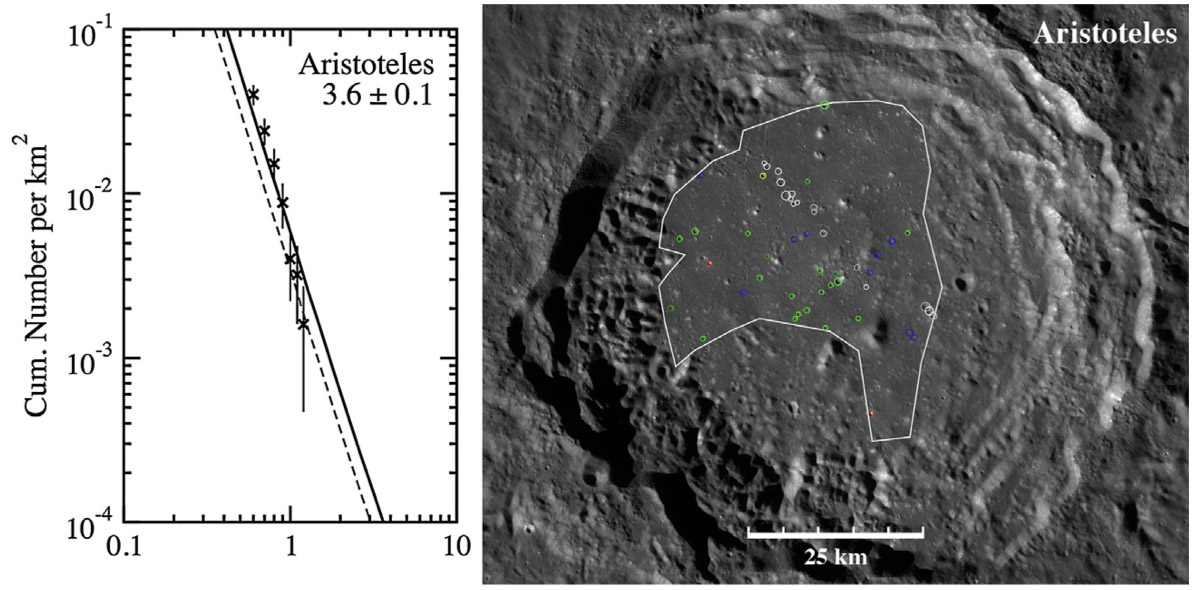December 28, 2013
Looking Over the Shoulder of a Lunar Scientist

image from M.R. Kirchoff et al. (2013) (click for PDF)
A recent publication by Michelle Kirchoff and colleagues at the Southwest Research Institute in Boulder, Colorado presented the model ages of 40 large impact craters of middle age*. Model ages are based on crater counts (using the 100 m/pixel LRO QuickMap mosaic), with a calibration equation that converts a measured cumulative number of craters per km sq surface area to ages in billions of years. The conversions are based on an equation that is the best fit to asteroid bombardment rates and terrestrial cratering rates, tied to radiometric ages of samples collected by Apollo astronauts. Large impact craters are about 90 -100 km in diameter, big enough to have a flat floor to count small superposed impact pits. Middle age craters are those formed between about 3.9 and 1 billion years ago, a period for which we have no definite ages based on radiometrically dated samples. Michelle and colleagues concluded that the impact cratering rated declined slowly after the assumed Late Heavy Bombardment 3.8 b.y. ago. This bombardment tail lasted until about 3.0 b.y. ago, and the rate since is speculated to have been relatively constant with occasional small spikes of more intense cratering. Today's LPOD outlines the floor area of Aristoteles crater with the colored circles being counted craters of different rim sharpness (from sharp/young to old: red, yellow, green, blue; white/gray circles are obvious secondaries not used in most age determination). Based on their analysis Aristoteles formed 3.6 b.y. ago. I am surprised that the age is so old for the crater has a crisp rim and few sizable superimposed craters. In fact, reading the text reveals that the model age of the crater is 2.7 b.y. but that if the secondaries are added - which makes little sense - the age of 3.6 is derived. Identification of secondary craters is always a concern in crater counting. What Michelle and colleagues have done, unlike most scientific papers, is provide a freely available database of their images, crater counts, reference materials and comments on uncertainty for each of the 40 craters. Thus, you can look at the evidence the authors used, see their interpretations and read their comments. All in all, that is a sobering lesson of how science is actually done, and how much interpretation is often behind conclusions that tend to be stated in black and white. This is a model paper of how the scientific process should be documented.
Chuck Wood
- Here are model ages (in billions of years) of some familiar craters according to this study:
Hayn, 1.8
Aristoteles, 2.7
Theophilus, 3.0
Geminus, 3.2
Hausen, 3.5
Pitiscus, 3.8
Hahn, 3.8
Icarus, 3.8
Manzinus, 3.8
Piccolomini, 3.9
Vlacq, 3.9
Related Links
21st Century Atlas chart 10.
[[M.R. Kirchoff et al. (2013) Ages of large lunar impact craters and implications for bombardment during the Moon’s middle age. Icarus 225 p. 325–341]]
Yesterday's LPOD: Two Little Known Valleys
Tomorrow's LPOD: All Alone
COMMENTS?
Register, Log in, and join in the comments.



